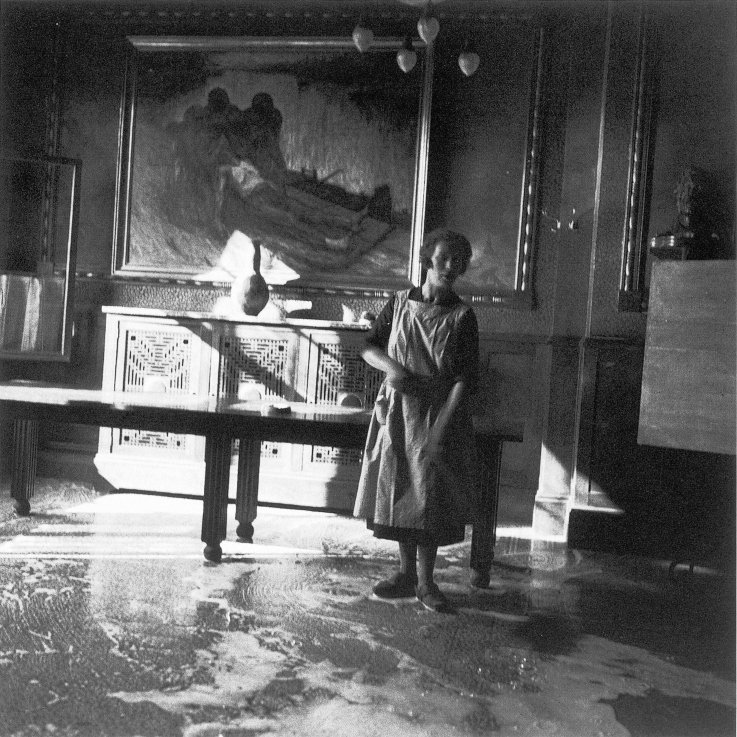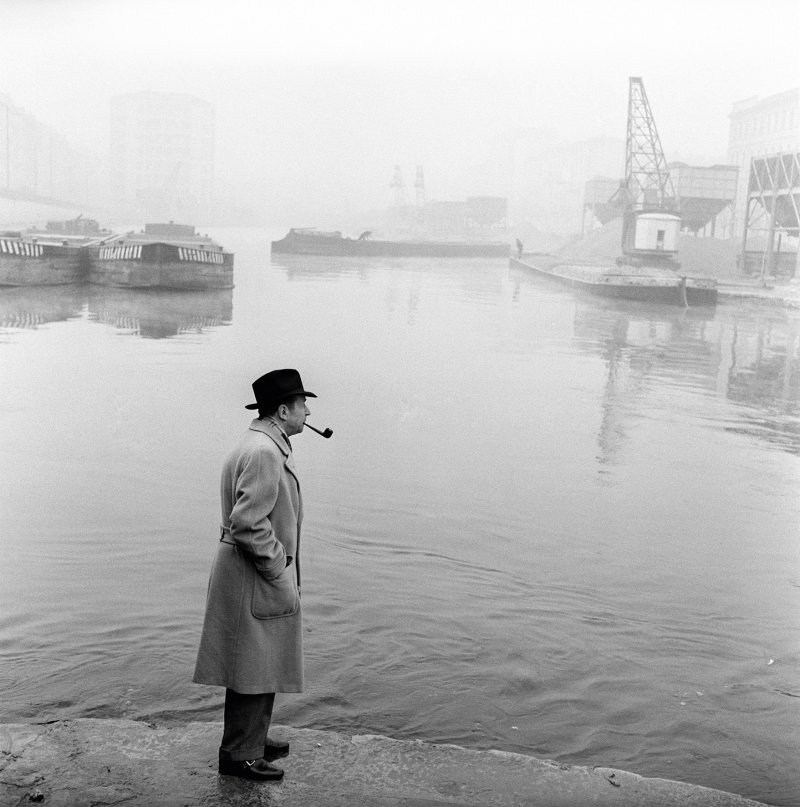
Georges Simenon (1903-89) was a phenomenon, a writing machine. The author of over 400 novels, published in 50 languages, with sales to date of more than 500 million copies, he is an awesome and awful monument to those of us who ply the same trade. This was a man who could write 80 pages a day at full speed. For example, between 1924 and 1931 he wrote 190 “popular” novels – trashy, ephemeral works, as he would have happily described them – under 17 different pen names. It’s hard to imagine anyone else like him; he makes Balzac look lazy.
That this toiling hack created Commissaire Maigret – a character as memorable and as enduring as Sherlock Holmes – is astonishing. That such incredible productivity resulted in works of literary fiction – his “romans durs” – that still possess an unrivalled potency is no less remarkable. Simenon is a unique monolith in the 20th-century literary landscape.
And Simenon was also – for a brief, fervid time – a photographer, another facet of this singular man to try to analyse and comprehend. He became a near obsessive photographer for a few years, in the first half of the 1930s. Simenon was then a young man, in his early thirties. Born in Belgium in 1903, he had been an enthusiast of photography from a young age and was able to develop and print his own images from his late teenage years. He insisted on photographic covers – very unusual at the time – for his early novels. He even wrote a novel illustrated by photographs taken by Germaine Krull. Photography was close to his creative heart.
[See also: AA Milne’s pacifism and patriotism]
A large exhibition of Simenon’s photographic output occurred in 2004 – at the Jeu de Paume in Paris – and a lavish catalogue was produced that explains why and how we know about this intriguing aspect of his artistic life. There are two ways of looking at the photographs Simenon took. The first is the insight they give us into what interested Georges Simenon – what drew his eye. The second is how they stand up as photographs in their own right.
Most of the photographs exhibited were taken as “reportage”. In the early 1930s Simenon was just beginning to taste the first fruits of success. He moved to France in 1922, where, having worked as a journalist and then as a writer, churning out sketches and what were known as “contes galants” – sensational, whimsical and erotic short stories for newspapers and magazines – he began to write novels under a series of pseudonyms.
Maigret made his first appearance in 1931 and slowly but surely Georges Simenon began to emerge from behind the palisade of his noms de plume. He published 31 titles with the Parisian imprint Fayard between 1931 and 1934 and began to make some serious money. He sold the film rights of his novel La Nuit de Carrefour to Jean Renoir. He was on his way. But Simenon did not abandon journalism – he couldn’t yet afford to. He undertook, in the early 1930s, a series of journalistic assignments, paid trips abroad – to Africa, to central Europe, to Russia and finally around the world – and his accounts of these journeys, illustrated by his own photographs, appeared in various magazines, including Voila and Paris Soir. This was the beginning of the great age of the illustrated magazine. The images taken on Simenon’s commissioned trips in the 1930s constitute the largest part of his photographic output.




The decisive moment: Simenon’s images of life in Poland and Belgium in 1933.
Credit: Simenon.TM, all rights reserved.
Simenon described himself as “un fabricant d’instantanés” – a maker of snapshots. And the “snapshot” is the key to understanding the motivation behind his photographic creativity, I believe. In fact, I have argued elsewhere that the “snapshot” is the defining factor of photography as an art form. The camera is a stop-time device. The image, mechanically produced, freezes and preserves a split-second in the endless flow of time. Painting can try to do this but it doesn’t come close. The camera’s ability to distinguish and enshrine a moment is its unique facility.
This is what so fascinated photographers in the early years of the 20th century. And by the time Simenon was taking photographs, the technology had moved on rapidly. Cameras had become small, light, sophisticated; 35mm film was highly responsive to available light. No special supplementary equipment was necessary to take a photograph – you simply needed to focus and press a button. It’s intriguing to think that as Simenon was taking his photographs in the 1930s, so too was the young Henri Cartier-Bresson (1908-2004). Both young men were captivated in their separate ways by what Cartier-Bresson called “the decisive moment” – another phrase for a snapshot. Simenon wasn’t in Cartier-Bresson’s league as a photographer but there’s no doubt that he was similarly fascinated by the camera’s potential to stop time. The photographer had become a “fabricant des instantanés”. It was a seductive power.
Simenon took many photographs on assignment as he travelled during those first years of the 1930s. A few dozen were reproduced in magazines to illustrate his articles but he kept all the others, dutifully sticking them into six large photo albums, all the images numbered, with places and dates added. These images were never exhibited during his lifetime, yet it’s obvious they were very important to him. It’s only after his death that we have come to know that there was this period of intense photographic activity in Simenon’s life.

The observer: Georges Simenon in Milan.
Credit: Emilio Ronchini/Mondadori via Getty Images
Most of the photographs conform, largely, to the genre of “reportage”. Here, the camera functions as a kind of vicarious eye, reproducing the lands the photographer travelled through and the people he encountered. Ethnographic reportage is, in its way, the simplest sort of photography to understand – the intrinsic interest of the image is paramount; any sort of aesthetic judgement is subsidiary. But what’s fascinating about Simenon’s reportage is how he, from time to time, undermines the documentary nature of the subject.
He took pictures, for example, in the estaminets and working-class bars of Charleroi in Belgium. Some of these images are worthy of the Hungarian-French photographer Brassaï. In Africa and Tahiti one can sense Simenon’s erotic interest in the unclothed, unselfconscious female form. Simenon was a sailor – he owned a large boat on which he lived for periods of his life when he was starting out as a writer. Many of his photographs are images of ships, docks, wharves and the life of a bustling harbour. But from time to time one senses that his real interest lies in the composition of clustered masts or of the curved gantries supporting lifeboats. These photographs are not illustrations to a travelogue; they are composed pictures that subscribe to a fine-art aesthetic. They are meant to be judged as photographs in their own right – photographs as an art form.
Time and again, Simenon’s photographs call to mind other photographers. His pictures of eastern Europe, of the poor in Romania, Lithuania and Poland, remind me of Roman Vishniac’s undying images of the Jewish shtetl. Simenon’s love of the snapshot – the image frozen, the subject’s feet raised from the ground, movement magically halted in mid-activity – recalls Jacques Henri Lartigue. Some of Simenon’s photos are out of focus, snatched quickly on the run, the camera tilted, but those errors don’t impede the success of the shot. His candid photos of people passing by remind me of that great American master of street photography, Saul Leiter.
[See also: Patricia Highsmith’s psychopath heroes]
Among the dutiful images required to illustrate the articles that Simenon would write, the photographer as artist emerges. In Africa he is moved to take a picture of a tall, stark standing tree – no use for an article. In Russia he takes a shot of three giggling girls on a beach, and a picture of a sunbather in Batum, Georgia, framed by the timbers of a half-finished beach house, that could be a Bill Brandt photograph. Compositionally, the image is perfect – the diagonals of the stark beams, replicated by their shadows on the shingle are almost abstract. It’s only a second glance that lets you pick out the tanned body of the prone sunbather.
Simenon was stretching and exploiting the potential of the camera in his hand. A ship in a storm, waves rushing over the fore-deck. Shots from high windows or decks looking down on people – where the purpose of the image is its design, not its import. New York’s skyscrapers are pictured through a haze of grainy light. Rigging, masts, deck-clutter, ladders and balustrades are taken for the special geometry of the image and not for any documentary purpose. There is one photograph of a girl in Tahiti making lei; the floral necklaces given out as symbols of welcome. She is deliberately off-centre; the long lens has removed any sense of depth of field so the background is indistinct, flattened. It’s an image that could have been taken yesterday – entirely modern in its composition and what it displays.
This image was taken on a round-the-world trip – also commissioned – that lasted 155 days during 1934-35. Looking through his work one begins to sense Simenon’s talents as a photographer congregating, growing richer, becoming more sophisticated on this journey. There are snatched candid portraits; images with lettering in them; experiments with texture, focus and light.




Global citizen: Simenon’s photographs of (top-bottom) the Belgian Congo, Tahiti, Russia and Malta.
Credit: Simenon.TM, all rights reserved.
And then he stopped. Suddenly. There are no more photographs taken of any interest – other than familial – for the rest of his life. Why? I suspect that he may have worried that an interest in photography might have impeded the main artistic project of his life – his novels. Very few novelists can practice more than one art form at a time.
But another reason may be biographical. All these photographs were being taken as the real Georges Simenon emerged, fully formed, as an author in his own right, discarding his many pseudonyms and the derisory hack work that had kept him in funds since he had come to Paris to make his name as a writer. That process was now fully under way and his focus on it – and its eventual success – was as intense and potent as ever.
[See also: The blossom-filled landscapes of Charles Conder]
However, that notion may also explain why the photographs of these years were so precisely annotated and so carefully preserved and then hidden away in their six albums. They represent a cusp in his life, a watershed. Maybe when he opened the albums from time to time it took him back to that “decisive moment” in his own journey. Perhaps they were crucial mementos – images taken by a young man on his way to becoming a world-famous writer. Another mystery to add to the aggregate of mysteries that is Georges Simenon.
William Boyd’s latest novel, “Trio”, is published by Viking
This article appears in the 24 Mar 2021 issue of the New Statesman, Spring special 2021





